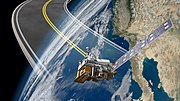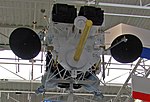Infrared Weather System – Geosynchronous
Infrared Weather System – Geosynchronous - Search results - Wiki Infrared Weather System – Geosynchronous
The page "Infrared+Weather+System+–+Geosynchronous" does not exist. You can create a draft and submit it for review or request that a redirect be created, but consider checking the search results below to see whether the topic is already covered.
 GOES 13 (redirect from Electro-optical/Infrared Weather System – Geosynchronous)EWS-G1 (Electro-optical Infrared Weather System Geostationary) is a weather satellite of the U.S. Space Force, formerly GOES-13 (also known as GOES-N...
GOES 13 (redirect from Electro-optical/Infrared Weather System – Geosynchronous)EWS-G1 (Electro-optical Infrared Weather System Geostationary) is a weather satellite of the U.S. Space Force, formerly GOES-13 (also known as GOES-N... Joint Operations of Infrared Weather Satellite". Archived from the original on 29 May 2023. Retrieved 29 May 2023. "Geosynchronous Space Situational Awareness...
Joint Operations of Infrared Weather Satellite". Archived from the original on 29 May 2023. Retrieved 29 May 2023. "Geosynchronous Space Situational Awareness... Geostationary orbit (redirect from Geosynchronous orbit derivation)geostationary orbit, also referred to as a geosynchronous equatorial orbit (GEO), is a circular geosynchronous orbit 35,786 km (22,236 mi) in altitude above...
Geostationary orbit (redirect from Geosynchronous orbit derivation)geostationary orbit, also referred to as a geosynchronous equatorial orbit (GEO), is a circular geosynchronous orbit 35,786 km (22,236 mi) in altitude above... On 8 September 2007 ISRO reported the satellite had reached a near geosynchronous orbit, and would be stabilized in its intended orbital position of 74...
On 8 September 2007 ISRO reported the satellite had reached a near geosynchronous orbit, and would be stabilized in its intended orbital position of 74...- weather predictions and the study of the environment of space. Significantly, this program focused on launching satellites to orbit geosynchronously and...
 Space weather is a branch of space physics and aeronomy, or heliophysics, concerned with the varying conditions within the Solar System and its heliosphere...
Space weather is a branch of space physics and aeronomy, or heliophysics, concerned with the varying conditions within the Solar System and its heliosphere... The Joint Polar Satellite System (JPSS) is the latest generation of U.S. polar-orbiting, non-geosynchronous, environmental satellites. JPSS will provide...
The Joint Polar Satellite System (JPSS) is the latest generation of U.S. polar-orbiting, non-geosynchronous, environmental satellites. JPSS will provide...- Defense System. It complemented the geosynchronous Defense Support Program, the Space-Based Infrared System, and other overhead non-imaging infrared (ONIR)...
- Lockheed Martin Space (redirect from Lockheed Martin Space System)build the fifth and sixth Geosynchronous Earth Orbit (GEO) satellites, known as GEO-5 and GEO-6, for the Space-Based Infrared System (SBIRS) at a cost of US$1...
 Satellite Control and Network Systems Division and in 2015 the Defense Weather Systems Directorate and Infrared Space Systems Directorate were combined into...
Satellite Control and Network Systems Division and in 2015 the Defense Weather Systems Directorate and Infrared Space Systems Directorate were combined into... The GOES system uses geosynchronous equatorial satellites that, since the launch of SMS-1 in 1974, have been a basic element of U.S. weather monitoring...
The GOES system uses geosynchronous equatorial satellites that, since the launch of SMS-1 in 1974, have been a basic element of U.S. weather monitoring...- Astrionics (redirect from Infrared horizon-scanning)Earth orbit to Geosynchronous orbit can use GPS for ACS. Another system which is vital to a spacecraft is the command and telemetry system, so much in fact...
 the Satcom-K1 communications satellite, second in a planned series of geosynchronous satellites owned and operated by RCA Americom; the deployment was successful...
the Satcom-K1 communications satellite, second in a planned series of geosynchronous satellites owned and operated by RCA Americom; the deployment was successful... NOAA-20 (category Weather satellites of the United States)generation of U.S. polar-orbiting, non-geosynchronous, environmental satellites called the Joint Polar Satellite System. NOAA-20 was launched on 18 November...
NOAA-20 (category Weather satellites of the United States)generation of U.S. polar-orbiting, non-geosynchronous, environmental satellites called the Joint Polar Satellite System. NOAA-20 was launched on 18 November... NASA (redirect from Space Systems Center)operation of polar and geosynchronous weather satellites. The relationship typically involves NASA developing the space systems, launch solutions, and...
NASA (redirect from Space Systems Center)operation of polar and geosynchronous weather satellites. The relationship typically involves NASA developing the space systems, launch solutions, and...- satellite operations. Applications include earth observation, radar, infrared, weather, telecommunications, and rural internet access among others. In 2009...
 Elektro-L No.2 (category Weather satellites of Russia)Elektro-L No. 2 satellite system was developed by Lavockhin and is part of the second generation of Russian geosynchronous weather satellites. The space platform...
Elektro-L No.2 (category Weather satellites of Russia)Elektro-L No. 2 satellite system was developed by Lavockhin and is part of the second generation of Russian geosynchronous weather satellites. The space platform... NOAA-21 (category Weather satellites of the United States)generation of U.S. polar-orbiting, non-geosynchronous, environmental satellites called the Joint Polar Satellite System. NOAA-21 was launched on 10 November...
NOAA-21 (category Weather satellites of the United States)generation of U.S. polar-orbiting, non-geosynchronous, environmental satellites called the Joint Polar Satellite System. NOAA-21 was launched on 10 November... List of government space agencies List of orbits List of satellites in geosynchronous orbit List of uncrewed spacecraft by program For constellations of multiple...
List of government space agencies List of orbits List of satellites in geosynchronous orbit List of uncrewed spacecraft by program For constellations of multiple... available very frequently (15 minutes or more often) from satellites in geosynchronous Earth orbit. IR works best in cases of deep, vigorous convection—such...
available very frequently (15 minutes or more often) from satellites in geosynchronous Earth orbit. IR works best in cases of deep, vigorous convection—such...
- These instructions are uplinked via geosynchronous Figure 2.2.—The basic intelligent Earth-sensing information system. Figure 2.3.—IESIS response to user
- Can't you do something? Mr. Dr. Possible: Well, I could put it in geosynchronous orbit, but I'm not sure how that would help. Adrena Lynn: [about Kim]
- Earth. Geosynchronous orbiting satellites orbit the Earth by matching the Earth’s spin, such that from Earth’s surface, a satellite in geosynchronous orbit













